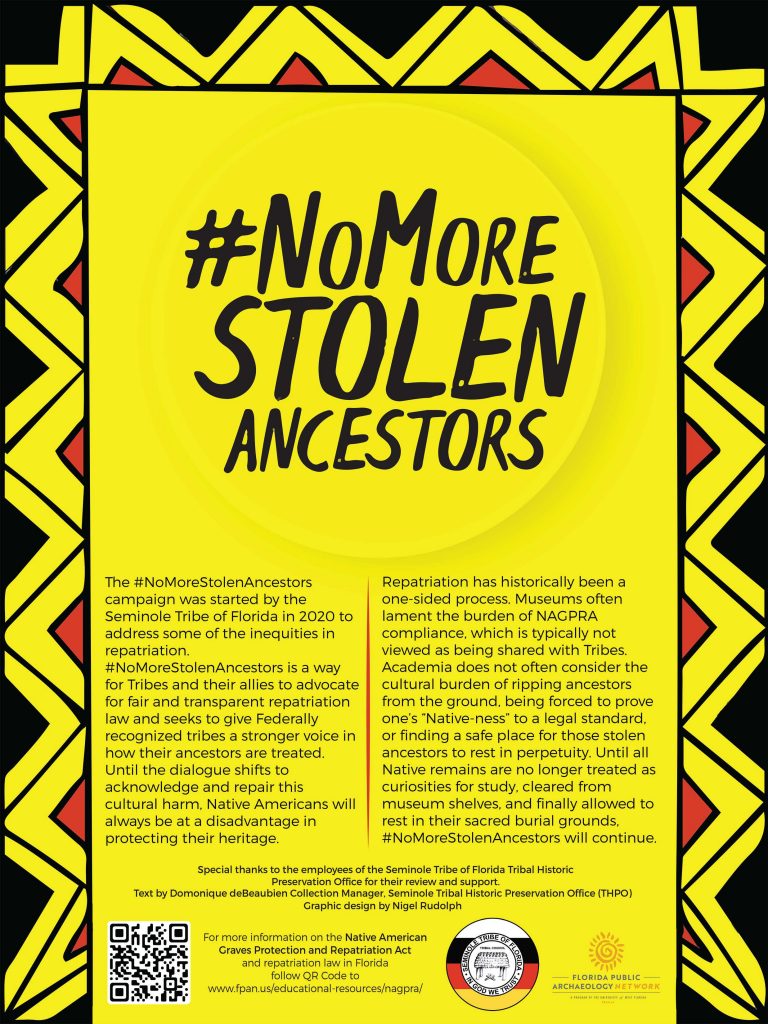Resources / Educational Resources
NAGPRA
Native American Graves Protection and Repatriation Act (1990)
Universities, museums, and other similar institutions in the United States hold in their collections the belongings and human remains of Native Americans. Early archaeologists dug up these remains as curiosities, and even later in the name of scientific pursuit. At last, through the protest and advocacy of Native people, legislation was passed to hold archaeologists and institutions to account for these collections.
In 1990, the Native American Graves Protection and Repatriation Act (NAGPRA) was passed to resolve the disposition of Native American cultural items and human remains. The statute and regulations outline the rights and responsibilities of lineal descendants, Federally recognized Indian tribes (to include Alaska Native villages), Native Hawaiian organizations, Federal agencies, institutions receiving Federal funding (“museums”) under the Act, and provide procedures for complying with NAGPRA.
Repatriation is defined as the act or process of returning or restoring someone or something to its place of origin. Regarding archaeology, it is the act of returning, or even reburying, human remains and artifacts to their rightful place as defined by Native descendants.
NAGPRA is federal law that provides a process for the repatriation or disposition of certain Native American cultural items – human remains, funerary objects, sacred objects, and objects of cultural patrimony – to lineal descendants, Federally recognized Indian tribes, and Native Hawaiian Organizations (NHO).
NAGPRA is property, Indian (government-to-government relations), and administrative law that affects archaeological fieldwork and curation. Foremost, it is human rights legislation that authorized an important change in the relationship between Native Americans and museums, requiring the latter to inventory their collections and identify human remains and cultural items, as well as to contact and consult with the appropriate tribal group(s) to arrange repatriation.
Federal agencies and all museums (under NAGPRA, museum is any institution, university, state agency, or local agency that receives Federal funds), except the Smithsonian Institution, are subject to NAGPRA. NAGPRA is complex for various reasons, from legal obligations to determining and negotiating which “community/communities” need to be served.
Selected web resources:
Federal
- National NAGPRA Homepage
- National NAGPRA Frequently Asked Questions (FAQs)
- Native American Graves Protection and Repatriation Act Regulations – Disposition of Culturally Unidentifiable Human Remains Rule (effective May 14, 2010)
- National Park Service – Managing Archaeological Collections – Introduction to Curation
- National Park Service – Managing Archaeological Collections – Laws, Regs, Policies, and Ethics
- National Museum of the American Indian Act (1989)
Tribal
- Seminole Tribe of Florida – Tribal Historic Preservation Office FAQs
- National Association of Tribal Historic Preservation Officers (NATHPO)
- “No More Stolen Ancestors” Campaign Urges Return Of Seminole Ancestral Remains – Seminole Tribune – Mar. 30, 2020
- “Seminoles’ Long Fight for Return of Stolen Ancestors Yields Results” – Seminole Tribe of Florida Press Release – Oct. 26, 2020
State
Download our poster, created in collaboration with the Seminole Tribe of Florida:
